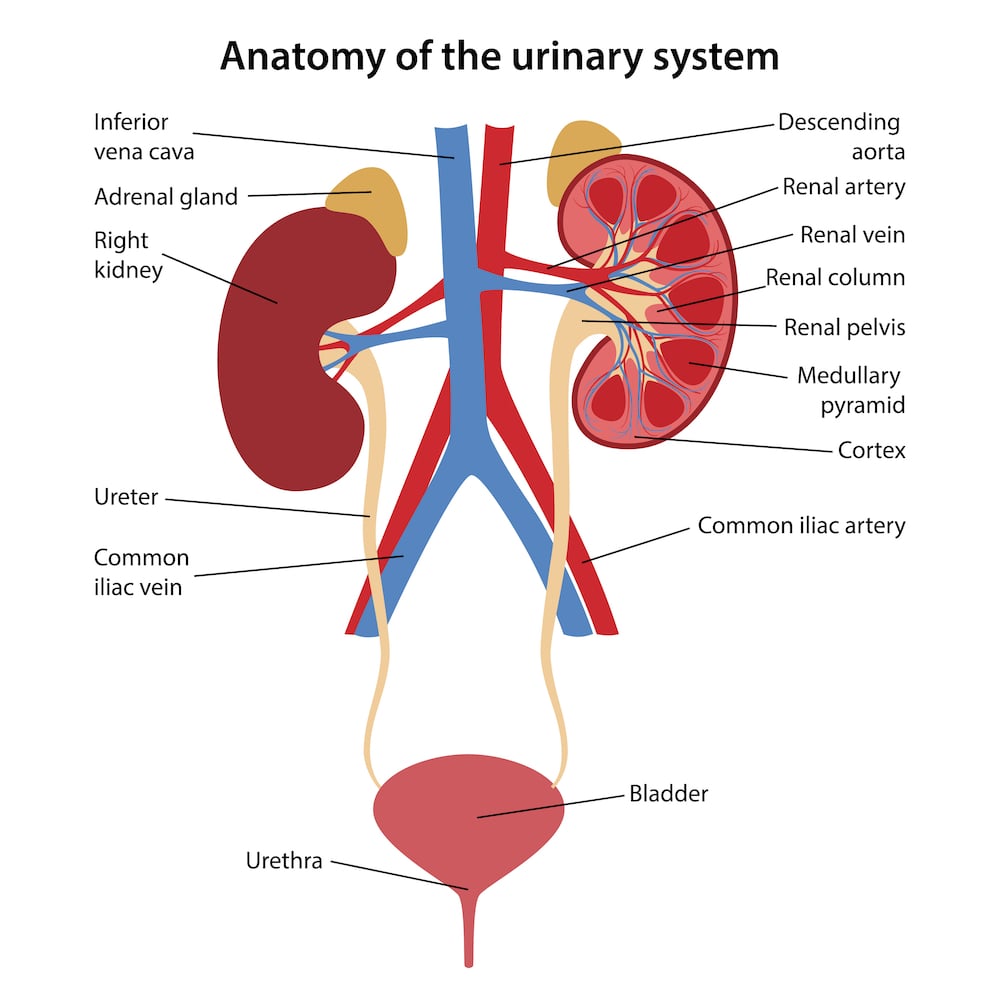
In the body, our kidneys form part of the genitourinary tract and serve many roles, including the production of urine, removing waste and excess fluid, and maintaining a healthy balance of salt, fluid, and minerals in the body. Sometimes, certain medical conditions may damage the kidney, and this may warrant further treatment to help restore kidney function, which can include surgery. In certain cases, kidney reconstruction may be preferable to removal so as to preserve kidney function.
A nephrectomy refers to the surgical removal of one kidney. In fact, the term is derived from the words nephro (kidney) and ectomy (removal).
While there are many reasons why a nephrectomy may be done, the main reasons usually include:
There are 2 main types of nephrectomies: partial and radical.


The type of nephrectomy that is done prior to a transplant is sometimes also referred to as a donor nephrectomy.
In cases of trauma, a nephrectomy may be performed if there is severe damage to the kidney leading to major blood loss and shock. Trauma can include blunt trauma and penetrating trauma with a sharp object. However, not all cases of renal trauma require surgery and nephrectomies are usually only done in severe renal injury. Sometimes, instead of a nephrectomy, a kidney reconstruction may be done instead to try to preserve as much healthy tissue as possible and to remove any tissue that is damaged.
With regards to the choice of surgery in renal trauma, many factors come into play, including the severity of the injury, level of renal injury, whether or not the patients’ vitals become unstable, and whether or not there is major blood loss.
Kidney reconstruction surgery is usually done under general anaesthesia and may be done either via traditional open surgery with a large incision down the abdomen or via laparoscopic surgery or keyhole surgery, which involves using smaller incisions and the use of surgical arms to access the kidney. Return advice will also be given after the surgery, and regular follow-ups with the urologist will be conducted to help monitor recovery and progress.
After a nephrectomy, kidney function will have to be carefully monitored. A urinalysis and blood tests will be carried out every year, and you may have to avoid certain activities to prevent accidental kidney injury.
Generally, it is possible to live a normal life with just one kidney because one kidney can filter enough blood to keep the body functioning normally. However, you are at an increased risk of developing kidney function impairment.
One must adopt a healthier lifestyle with just one kidney. Alcohol intake should be carefully monitored and taken in moderation, but is generally allowed unless you have been advised otherwise by your urologist.
Generally, your urologist may order several imaging tests such as computed tomography (CT) scans and magnetic resonance imaging (MRI) scans, and maybe biopsies to find and definitively diagnose whether the kidney tumour is cancerous.
A pyeloplasty is a form of reconstructive surgery that relieves urinary obstruction at the ureteropelvic junction. This helps drain and decompress the kidney.
A pyeloplasty is done to correct a Ureteropelvic Junction (UPJ) Obstruction, which is a blockage in the area that connects the renal pelvis to the ureters, causing urine retention in the kidney.
This may be a congenital abnormality or, less frequently, happens in adults due to kidney stones, upper urinary tract infections, an abnormally crossing blood vessel or swelling in the urinary tract.
Pyeloplasty can be done via open surgery or minimally invasive surgery (MIS), such as robotic surgery. Patients are usually put under general anaesthesia for the procedure. The surgery works to relieve obstruction by removing the blocked segment of the ureter and reattaching the remaining healthy segment to the kidney. This way, the renal pelvis will end up being reattached to ureter tissue with a patent lumen, thereby relieving the obstruction.
Overall, pyeloplasty is useful in helping to reduce pressure in the kidney by helping to drain obstructed portions. The procedure has good long-term success and is typically very effective in helping to relieve obstruction in the kidney.
This depends on the type of pyeloplasty done. Generally, an open pyeloplasty takes 8-12 weeks, while a robotic pyeloplasty takes about 3-4 weeks for recovery.
It will depend on the severity of the obstruction. In patients with mild UPJ obstruction, surveillance may be all that is required. However, treatment is recommended if the patient suffers from recurrent infections, pain, increased swelling, and if kidney function worsens. If left untreated, it may lead to loss of kidney function, sepsis or even death.
An Endopyelotomy is an alternative minimally invasive procedure to treating Ureteropelvic Junction (UPJ) Obstruction. It involves passing a ureteroscope (a small, hollow tube) with a video camera attached through the ureter. Entry can be done percutaneously (via an incision in the skin), or through the bladder.
When the narrow area of the ureter is reached, a thin wire will be inserted passed the narrow area up to the kidney under x-ray control, and a surgical instrument or laser will be used to cut through the ureter at the point of narrowing and obstruction. A temporary drainage tube (stent) will be inserted into the lumen at the end of the procedure to help make sure that the lumen of the ureter stays open after the surgery. The stent will be removed a few weeks after the procedure during a follow-up appointment with the urologist, where the kidney function (including its ability to drain urine) will also be assessed.

An endopyelotomy stent is used to help drain urine during a UPJ procedure, and reduce the risk of postoperative narrowing of the ureteral lumen.
Here at the Assure Urology & Robotic Centre, we provide many surgical options to help meet your treatment needs. Depending on your medical background and current condition, your urologist will discuss the best type of renal construction surgery for you.

MBBS, MRCSed, MMED(Surgery)
Dr Terence Lim is a Senior Consultant Urologist with a subspecialty in Uro-Oncology. He is also the Medical Director at Assure Urology & Robotic Centre. His clinical interests include Uro-Oncology, Minimally-invasive Urological Surgery, Urinary Stone Disease, Endourology and Prostate Health.
Prior to his private practice, Dr Terence Lim spent almost two decades in public healthcare. He served as the Senior Consultant and Chief of the Department of Urology at Changi General Hospital (CGH). In addition, he is currently a Visiting Consultant at CGH. Dr Lim was also the director of CGH’s Advanced Surgical Centre, a committee dealing with complex surgeries, including robotic surgeries.
Your health is important to us and some conditions require immediate attention. For emergencies, please contact us at 9835 0668.

MBBS, MRCSed, MMED(Surgery)
Dr Terence Lim is a Senior Consultant Urologist with a subspecialty in Uro-Oncology. He is also the Medical Director at Assure Urology & Robotic Centre. His clinical interests include Uro-Oncology, Minimally-invasive Urological Surgery, Urinary Stone Disease, Endourology and Prostate Health.
Prior to his private practice, Dr Terence Lim spent almost two decades in public healthcare. He served as the Senior Consultant and Chief of the Department of Urology at Changi General Hospital (CGH). In addition, he is currently a Visiting Consultant at CGH. Dr Lim was also the director of CGH’s Advanced Surgical Centre, a committee dealing with complex surgeries, including robotic surgeries.
Your health is important to us and some conditions require immediate attention. For emergencies, please contact us at 9835 0668.
No issue is too small. Contact any of our friendly staff and we will get back to you as soon as possible.
Reach out to us for expert urological care.
For enquiries, leave a message and our friendly team will get in touch with you.
For urgent enquiries after office hours, call or WhatsApp us at (65) 9835 0668.
Monday – Friday: 9:00AM – 5:00PM
Saturday: 9:00AM – 12:30PM
Sunday & Public Holiday: CLOSED

© 2023 All Rights Reserved | Assure Urology & Robotic Centre | Terms & Conditions